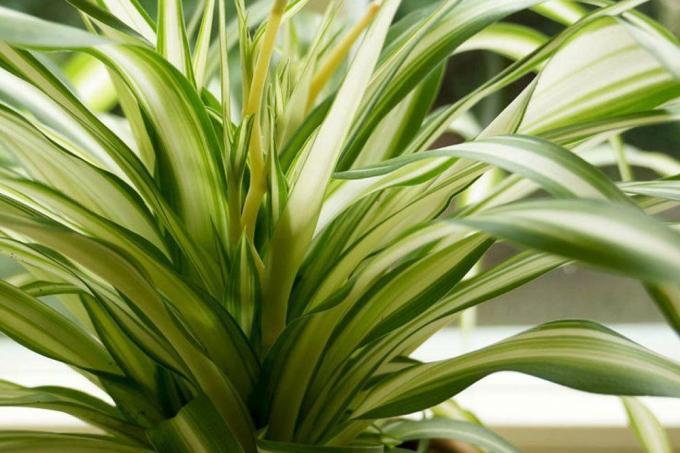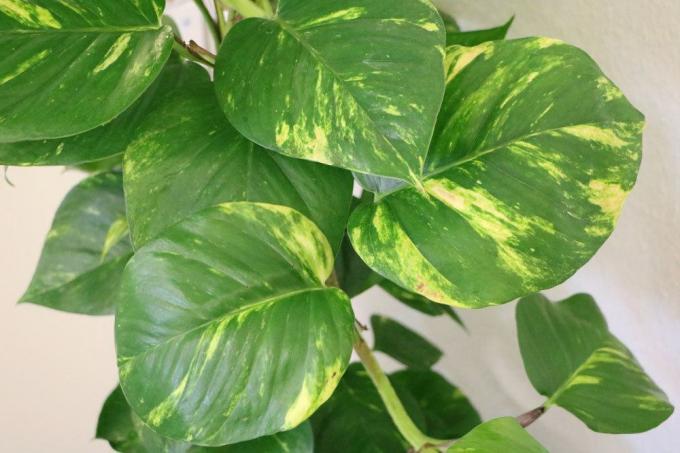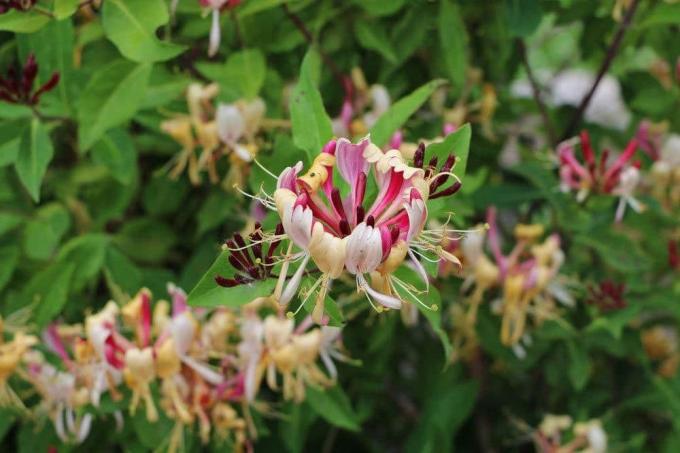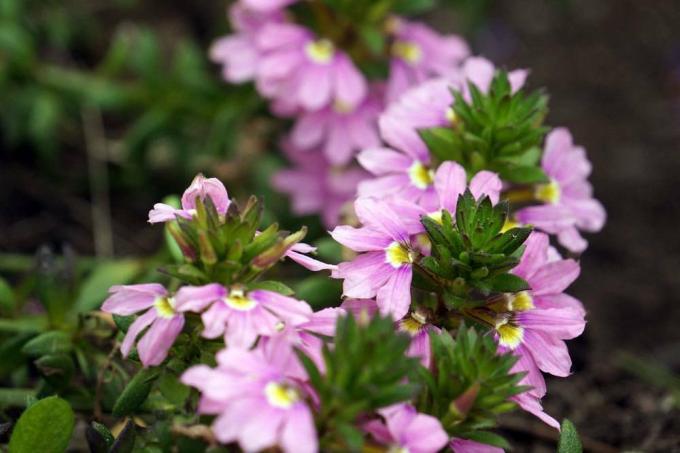
table of contents
- Hanging plants in the house
- Plants from A - F
- Plants from G - R
- Plants from S - Z
- garden
- balcony
- frequently asked Questions
Hanging plants give planted pots additional structure, but are also suitable for hanging baskets. Which hanging plants grow in shady places is stated in this text.
In a nutshell
- Hanging plants don't always have to grow in hanging baskets
- Green plants are usually more shade-friendly than flowering plants
- some types are equally suitable for the house, garden and terrace
Hanging plants in the house
In the house, hanging plants are usually planted in hanging baskets or hung on the wall as decoration, where they often get little light.
Note: It is important to ensure that the plants are never placed so high that they are unnecessarily difficult to care for.
Plants from A - F
Leaf begonias

- Origin: Asia, Africa, America
- Characteristics: bushy, overhanging, mostly multi-colored leaves, such as green / red or light / dark green, flowers small and inconspicuous, need little light
- Substrate: normal, well-drained potting soil
- Care: water regularly and provide fertilizer for green plants, repot in spring
- Propagation: by cuttings or division
- Diseases and pests: powdery mildew, root rot in waterlogging, thrips, aphids
- Varieties: Tiger Begonia (Begonia boweri), King Begonia (Begonia-Rex-Hybride), Begonia-Corallina-Hybrids
Efeutute (Epipremnum pinnatum)

- Origin: Asia, Australia
- Properties: likes to climb climbing aids, but also grows hanging, green plant with grained leaves
- Substrate: without special demands on the soil
- Care: high humidity is an advantage, water and fertilize regularly, avoid waterlogging, repot every two years, pruning is possible
- Propagation: via cuttings
- Diseases and pests: hardly susceptible, root rot when waterlogged
Pea plant (Senecio rowleyanus), string of pearls

- Origin: Africa
- Properties: Succulents, grows overhanging or carpet-like, forms long shoots with leaves that are thickened like pearls, therefore good hanging plants for shady places, forms small flowers
- Substrate: cactus soil, well-drained, low in nutrients, mix normal soil with sand
- Care: seldom water and fertilize, repot when there is no more space in the pot
- Propagation: via cuttings
- Diseases and pests: lice
Plants from G - R
Antler fern (Platycerium bifurcatum)

- Origin: Asia, Australia
- Characteristics: overhanging, evergreen, large fronds, epiphytes
- Substrate: slightly acidic orchid soil
- Care: it is best to dip once a week, fertilize every four weeks, repot every two years
- Propagation: via side shoots
- Diseases and pests: scale insects
Golden beard (Callisia fragrans)
- Origin: Mexico
- Properties: grows like bromeliads, forms long, overhanging shoots
- Substrate: well drained, not too nutritious soil
- Care: water and fertilize moderately, repot annually in spring
- Propagation: via cuttings
- Diseases and pests: if the air is dry, spider mites, tripods and lice
Green lily (Chlorophytum comosum)

- Origin: South Africa
- Characteristics: green or green / white specimens, forms kindling and long flower stems even when there is little light, grows overhanging
- Substrate: nutrient-rich, loose soil, likes moist
- Care: easy to care for, water and fertilize regularly, repot annually
- Multiplication: division, Kindel
- Diseases and pests: robust
Gundelrebe (Glechoma hederacea), Gundermann

- Origin: native
- Characteristics: creeping, overhanging growth, green or two-colored leaves, purple flowers
- Substrate: potting soil, without special requirements
- Care: water regularly and fertilize a little
- Propagation: via cuttings
- Diseases and pests: hardly susceptible
Note: The Gundermann is also one of the most suitable hanging plants for shady places in the garden.
Climbing Philodendron (Philodendron scandens), climbing tree friend

- Origin: Central and South America
- Characteristics: usually climbs, but also suitable for traffic lights, evergreen
- Substrate: nutrient-rich, well-drained
- Care: water and fertilize regularly, repot every two years, compatible with pruning
- Propagation: via cuttings
- Diseases and pests: mealybugs and spider mites, otherwise robust
Coral cactus (Rhipsalis baccifera)

- Origin: comes from the tropics
- Characteristics: grows overhanging, green, forms long, branched shoots
- Substrate: loose, humus, possibly soil for bromeliads or other epiphytes
- Care: water and fertilize regularly, repot every two years, compatible with pruning
- Propagation: via cuttings
- Diseases and pests: lice
Plants from S - Z
Shame Flower (Aeschynanthus)

- Origin: Asia
- Properties: evergreen epiphyte, shoots up to 60 cm long, flowers in yellow, orange and red
- Substrate: permeable soil, possibly mix with fine gravel, sand or clay granules
- Care: do not water and fertilize too often, the plant likes to stand dry, repot annually
- Propagation: cuttings
- Diseases and pests: too little humidity leads to spider mites and possibly also aphids
Sword fern (Nephrolepis exaltata)

- Origin: tropical forests
- Characteristics: evergreen, forms overhanging fronds, epiphytes
- Substrate: nutrient-poor potting soil
- Care: keep moist, fertilize regularly, repot every three years, spray from time to time
- Propagation: via division or runners
- Diseases and pests: if the air is dry, spider mites
Ornamental asparagus (Asparagus densiflorus)

- Origin: Asia, Africa
- Properties: Green plant for little light with overhanging growth, long and branched shoots, leaves transformed into "needles"
- Substrate: no requirements, normal potting soil is sufficient
- Care: keep moist, fertilize regularly, spray from time to time every two, later three years repot
- Multiplication: via division
- Diseases and pests: spider mites, aphids, do not place too dry, also avoid waterlogging
garden
Real creepers can be good hanging plants for shady places in the garden. These include ivy and honeysuckle. Some ground cover such as periwinkle or pennywort are also suitable for locations with little light.
Ivy (Hedera helix)

- Origin: native
- Properties: evergreen, climbs, forms adherent roots, but also grows overhanging, blooms late, good for insects
- Substrate: well drained soil, otherwise undemanding
- Care: keep moist, fertilize little, cut compatible
- Propagation: via cuttings
- Diseases and pests: fungal diseases or bacteria, otherwise robust
Note: Ivy is very universally applicable. There are also varieties that are suitable as hanging plants for shady places in the house or on the balcony.
Honeysuckle (Lonicera)

- Origin: partly indigenous
- Characteristics: looping, climbing, overhanging growth, there are evergreen varieties, sometimes have very beautiful, fragrant flowers
- Substrate: loose, nutrient-rich soil
- Care: mulch, keep slightly moist, fertilize from time to time, cut compatible
- Propagation: via cuttings
- Diseases and pests: watch out for aphids, otherwise robust
Periwinkle (Vinca)

- Origin: native, but also from Asia
- Characteristics: cushion-forming, overhanging growth, evergreen, with purple, rarely white flowers
- Substrate: nutrient-rich, loose soils
- Care: keep slightly moist, fertilize with compost, cut compatible
- Propagation: by cuttings, rooted side shoots
- Diseases and pests: fungal diseases
Pennywort (Lysimachia nummularia)

- Origin: native
- Characteristics: not very demanding, also grows in sunny places, yellow flowers, creeping habit, also forms overhanging shoots
- Substrate: nutrient-rich, well-drained
- Care: easy to care for, little watering or fertilizing, cut compatible
- Multiplication: via division
- Diseases and pests: robust
Loquat (Cotoneaster dammeri), loquat

- Origin: China
- Properties: creeping grows, forms long, overhanging shoots, white flowers, red berries, evergreen, slightly poisonous
- Substrate: permeable, nutrient-rich soil
- Care: fertilize now and then, water only when it is dry, can be cut into shape
- Propagation: shoots form roots when they come into contact with the ground, cut off rooted shoots
- Diseases and pests: possibly fire blight
balcony
Hanging balcony plants bring more structure to the planting. They close holes between the other flowers and visually enlarge the flowering area.
Blue fan flower (Scaevola aemula)

- Origin: Australia
- Characteristics: grows overhanging, blue, white or pink flowers
- Substrate: moist, but well-drained, mix soil with a little sand
- Care: water and fertilize regularly, otherwise easy to care for, overwinter in the house
- Propagation: via cuttings
- Diseases and pests: relatively insensitive, possibly whitefly
Hanging Begonia (Begonia boliviensis)

- Origin: South America
- Characteristics: grows overhanging, forms orange and red flowers
- Substrate: permeable soil for balcony plants
- Care: water and fertilize regularly, overwinter in the house, repot in spring, regularly remove faded
- Propagation: via cuttings
- Diseases and pests: aphids or gray mold, generally less susceptible
Hanging fuchsia (fuchsia)

- Origin: Central and South America
- Characteristics: flowers in many different colors, overhanging growth
- Substrate: nutrient-rich, well-drained soil
- Care: do not water too often, does not tolerate root moisture, fertilize regularly and remove faded, overwinter in the house and repot in spring
- Propagation: via cuttings
- Diseases and pests: fungal diseases or lice
frequently asked Questions
One possibility is to remove all plants and bring them into the house when there is a storm. Otherwise, there is still the option of fixing the hangers in such a way that they cannot fall off by themselves. To do this, they can be tied or screwed on.
Even hardy plants are better protected if the tub is wrapped in jute or fleece in winter. The reason for this is that freezing the substrate through can lead to even hardy plants freezing to death.
For some species this is necessary. Be it to restrict growth, to bring it into shape or just to remove what has faded. The latter is recommended for all flowering plants, because they stay beautiful longer and often bring new flowers.
